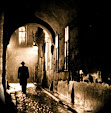
The expertly constructed Swedish vampire film Let The Right One In is one of those rare movies that is more notable for what it suggests to its audience than what it actually shows them. Director Tomas Alfredson’s film just may be the best shot movie of last year, and the style he employs is at times so slight and subtle that the smallest look or gesture is able to speak volumes about its characters and their bizarre relationship. This is certainly a horror movie, faithful to the mythology of the vampire and with several striking scenes of violence, but at its heart it is one of the more keenly observed films about human relationships to come along in some time.
The story follows 12-year-old Oskar, a young boy living in a suburb of Stockholm in 1982. Oskar is an outsider at his school, where a group of bullies is constantly terrorizing him, and even more alienated from his parents, who are separated and seem to have very little to do with him. He is seemingly alone in the world, until he meets Eli, a girl his age who has just moved in next door. Eli is certainly strange-- she doesn’t go to school and only seems to come around at night, and her arrival coincides with a series of grisly murders in around the town-- but Oskar is happy to have a friend, and eventually asks if she’ll be his girlfriend. She hesitantly agrees, as long as he realizes that she’s “not really a girl.” Soon the two are spending as much time together as they can, and Eli is coaching Oskar on how to fight back against his tormentors.
Oskar’s reaction to learning that Eli is a vampire is certainly unexpected, and moves the story toward its more surreal final third, but it works because of how well-constructed the dynamic between the two is, and how natural their interactions have been to that point. The majority of the credit should go to the wonderful young actors playing the duo, Kare Hedebrant and Lina Leandersson, but the film’s script, adapted by John Ajvide Lindqvist from his novel, is also spot on, and features some of the most beautifully simple dialogue I’ve heard in a while. Take the oddly funny scene where Oskar, upon learning that Eli is indeed a blood-drinking vampire, asks her how old she really is. “I’m twelve,” she insists, “but I’ve been twelve for a very long time.”
Director Tomas Alfredson’s style is impeccable, and is a big part of what makes the film’s meaning so rich and multilayered. He makes use of a largely static camera to capture the unusually foreboding backdrop of the town, often using long shots to let the atmosphere swallow up the characters. After watching the film, one can’t imagine the Swedish landscape, with its snow covered streets and pitch-black night skies, being shot any differently. The comparison to fellow Swede Ingmar Bergman is probably too easy, but Alfredson’s camera seems to capture the film’s landscape and the faces of its characters with the same kind of emotional intensity that makes films like Winter Light so memorable, and like Bergman he delivers several beautifully composed shots that will stay with the viewer long after the film is over. His deliberate pacing is also Bergman-esque, but it is punctuated by some staggeringly brutal scenes of violence that rival some of the horror genre’s masters in their originality and intensity. Alfredson handles these scenes with a matter-of-fact kind of style that lends an elusive quality to the violence. Avoiding the quick cuts and shaky camera that plague so many American horror films, he uses long shots in these scenes to place the viewer at a distance and give the odd feeling of being a witness to the killings, which unfold with the speed and ferocity of an animal attack.
Outside of these scenes, the pacing and style of the film is quite subdued. Alfredson feeds the audience very little through dialogue, and his directing style might as well be a master course on how to tell a story visually. Every scene is altered and the surface meaning complicated by a simple shot or a cut scene, and as the film progresses we begin to see that the seemingly innocent relationship between Oskar and Eli is becoming more and more clouded.
Still, in the end it is this relationship, in all its complexities and terrifying implications, that makes Let The Right One In work so well. Eventually, we begin to see that the title doesn’t just refer to the old lore that a vampire must be invited into someone’s home before they can enter it, but also to the interaction between the two main characters, who are slowly letting another person truly know them after a life of feeling alone. Oddly, and despite all the gothic trappings that come along with being a vampire story, Let The Right One In is at its heart an elegantly simple film about two outsiders finally finding a person they can relate to, and it’s this emotional core, twisted though it may be, that grounds the film and makes the fantastical elements seem all the more natural.
TRAILER:


No comments:
Post a Comment